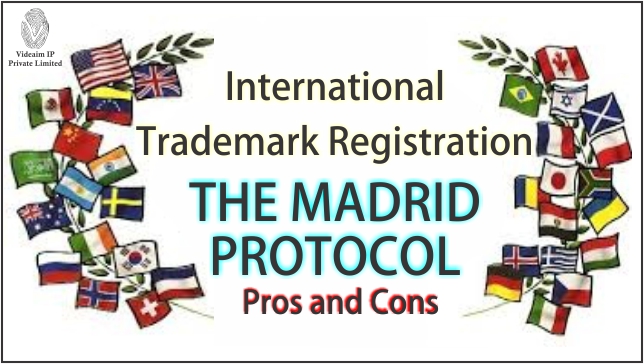
International trademark registration is facilitated through the Madrid System, which is governed by two international treaties: the Madrid Agreement Concerning the International Registration of Marks (Madrid Agreement) and the Protocol Relating to the Madrid Agreement (Madrid Protocol). These treaties are administered by the World Intellectual Property Organization (WIPO).
What is the Madrid Protocol?
The Madrid Protocol is an international treaty that facilitates the international registration of trademarks. It was adopted in 1989 in Madrid, Spain, and is administered by the World Intellectual Property Organization (WIPO). The primary objective of the Madrid Protocol is to simplify the process for trademark registration in multiple countries by allowing applicants to file a single international application in their home country and extend protection to multiple member countries.
Advantages of the Madrid Protocol:
- Simplified International Registration: The Madrid Protocol simplifies the process of registering trademarks internationally by allowing applicants to submit a single application in their home country, which can then be extended to multiple member countries.
- Cost-Effective: The centralized filing system can be cost-effective for businesses seeking protection in multiple countries, as it eliminates the need to engage separate legal representatives and navigate individual application processes in each country.
- Streamlined Maintenance: The renewal and management of trademark registrations are centralized through the International Bureau of WIPO, making it easier for applicants to maintain and renew their trademark protection.
- Flexibility in Designating Countries: Applicants can choose the specific member countries where they want to extend protection, providing flexibility and cost control based on business needs.
Disadvantages of the Madrid Protocol:
- Dependency on Home Application: The success of an international registration depends on the acceptance of the home application. If the home application is rejected or cancelled within a certain period, the international registration may be affected.
- Central Attack: If the original home registration is challenged or cancelled, it may affect the corresponding international registrations in other member countries.
- National Examination Requirements: While the Madrid Protocol streamlines the filing process, it does not harmonize the substantive examination of trademark applications. Each member country retains the right to examine and refuse applications based on their national laws and regulations.
- Limited to Member Countries: The Madrid Protocol is only applicable in member countries. Some countries may choose not to join the agreement, and in such cases, separate applications would still be necessary.
HOW TO FILE AN INTERNATIONAL TRADEMARK APPLICATION THROUGH INDIAN PATENT AND TRADEMARK OFFICE
Filing an international trademark application in India using the Madrid Protocol involves a series of steps. Here’s a general guide to help you understand the process:
Step 1: Determine Eligibility
Ensure that you meet the eligibility criteria for filing an international trademark application under the Madrid Protocol. Generally, you need to have an existing national trademark application or registration in your home country.
Step 2: Home Application or Registration
Before using the Madrid Protocol, you should have either:
- A pending trademark application in your home country, or
- An existing trademark registration in your home country.
Step 3: File the International application through the National Office
Contact the Indian Patent and Trademark office. Submit the required documents and fees for an international trademark application under the Madrid Protocol (Offline or online).
You must file Form MM2 and in the US you will have to file MM-18E in order to submit an application to the national office. The office will certify your application and forward it to the World Intellectual Property Organization (WIPO). This evaluation’s main purpose is to verify that your application is error-free and it has been forwarded to be approved and published in the WIPO’s International trademark gazette.
A second application in Form MM-18(E) must be filed if the foreign country is a member of the European Union, and the applicant must specify a second language if the country is the US other than French, German, Italian, or Spanish. The international application must be fulfilled in the prescribed Form MM-2(E).
Step 4: Designate Countries
In your international application, you can designate the countries where you seek protection. Specify the goods and services for which you want trademark protection in your country of choice.
Step 5: Examination by National Trademark Office of Each Country
The international application is then transmitted to the National Trademark Office for examination. The National Trademark Office will examine the application based on national laws and regulations.
Step 6: National Processing
If the National Trademark Office raises no objections or if any objections are successfully overcome, the mark will be accepted for protection in that country. The international registration will then have the same effect as a national application.
Important Points to Consider:
The entire process is managed through the WIPO system, but each designated country will conduct its own examination.
It’s crucial to ensure that the goods and services specified in your application comply with the National classification system of that country. Any changes, renewals, or modifications to the international registration can also be managed through the WIPO system.
CONCLUSION
It’s important to note that the success of an international trademark registration depends on the acceptance by each designated country. If a designated country refuses protection, the protection in that country will not be granted.
Before initiating the international trademark registration, it’s advisable to consult with a trademark attorney or professional who can provide guidance specific to your situation and help navigate the complexities of the process.
